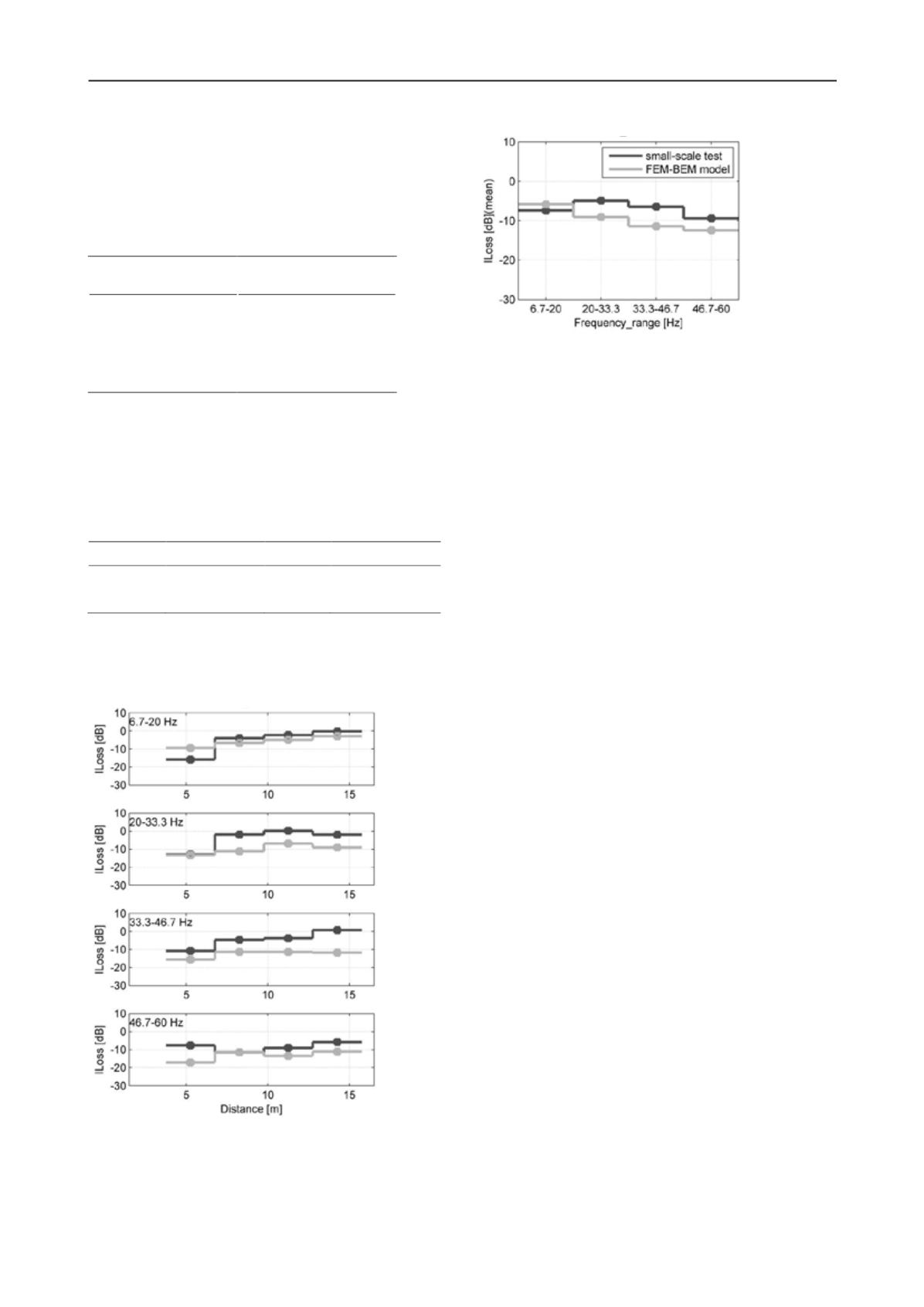
938
Proceedings of the 18
th
International Conference on Soil Mechanics and Geotechnical Engineering, Paris 2013
In this methodology, 2.5D FEM is used to model the structure
(the screen) and the soil impedance as well as the free field
vibrations are computed by means of 2.5D BEM. This
methodology has been already examined for different
applications such as railway tracks, roads, tunnels, dams,
trenches, and pipelines by François et al. (2010).
Table 3 Frequency ranges in the full scale and the small-scale test.
Small-scale test
N=15
Full-scale test
100-300 [Hz]
6.7 – 20 [Hz]
300-500 [Hz]
20 - 33.3 [Hz]
500-700 [Hz]
33.3 - 46.7 [Hz]
700-900 [Hz]
46.7 – 60 [Hz]
The barrier has a width of 0.04*15 = 0.60 m and a depth of
0.4*15 = 6 m. Table 3 shows the frequency ranges that have
been applied for the measurements.
The same soil properties as obtained in the test bench are
considered. A soft layer over a homogeneous half space is
considered. The soil characteristics are presented in table 4. The
soil has a material damping of 5%.
Table 4 Soil properties in numerical modeling.
Layer depth Young’s modulus Density Shear wave velocity
3 [m]
33.5 [MPa]
1660 kg/m³
85 [m/s]
∞
65 [MPa]
1690 kg/m³
120 [m/s]
Figure 7 shows the variation of the insertion loss versus the
distance. Results of the experimental test bench (dark line) are
compared with those of the numerical modeling (gray line).
The frequency range as well as the distance from the source is
presented in the real scale.
Figure 7. Insertion loss versus distance from the source.
An average insertion loss can also be calculated for each barrier
over all distances. A reasonable agreement between the
experimental and numerical simulation is observed, figure 8.
Figure 8. Average insertion loss at different excitation frequencies.
4 CONCLUSIONS
A test bench has been fabricated for the examination of the
isolating screen efficiency. Results of the small-scale test show
a reasonable agreement with those obtained by the numerical
modeling. This confirms the accuracy of the numerical
prediction for further investigation.
In addition, results show that the selected concrete screen with a
depth of 6 m (
~0.8
) is not efficient enough to mitigate the
vibrations at frequencies lower than 30 Hz. At higher
frequencies where
/
is greater than one, however, higher
efficiency has been obtained.
5 ACKNOWLEDGEMENTS
The results presented in this paper have been obtained within
the frame of EUROSTAR SOILVIBES project "Railways
vibration mitigation in transmission path".
This project is funded by IWT Vlaanderen, the Institute of the
Promotion of Innovation by Science and Technology in
Flanders. Their financial support is gratefully acknowledged.
6 REFERENCES
Adam M. and von Estorff O. 2005, Reduction of train-induced
vibrations by using open and filled trenches.
Computers and
Structures
, 83:11–24.
Altaee A. and Fellenius B.H. 1994, Physical modeling in sand.
Canadian geotechnical journal
31, 420-431.
Celebi E., Firat S., Beyhan G., Cankaya I., Vural I., and Osman K..
2009, Field experiments on wave propagation and vibration
isolation by using wave barriers.
Soil Dynamics and Earthquake
Engineering
, 29:824–833.
François S., Schevenels M., Galvin P., Lombaert G., and Degrande G..
2010, A 2.5D coupled FE-BE methodology for the dynamic
interaction between longitudinally invariant structures and a layered
half space.
Computer methods in applied mechanics and
engineering
, 199(23-24):1536 – 1548.
Garnier J., Gaudin C., Springman S.M., Culligan P.J., .Goodings D,
Konig D., Kutter B., Phillips R., Randolph M.F., and Thorel. L.
2007, Catalogue of scaling laws and similitude questions in
geotechnical centrifuge modelling
. International Journal of
Physical Modelling in geotechnics
, 7(3):1–24.
Miura S. and Toki S. 1982, A sample preparation method and its effect
on static and cyclic deformation-strength properties of sand
. Soils
and Found
.
, 22(1):61–77.
Sieffert J.G. and Cevaer F. 1991,
Handbook of impedance functions,
surface foundations
, Ouest editions.
Vaid Y. P., Sivathayalan S., and Stedman D. 1999, Influence of
specimen-reconstituting method on the undrained response of sand.
Geotechnical Testing Journal
, 22(3):187–195.


